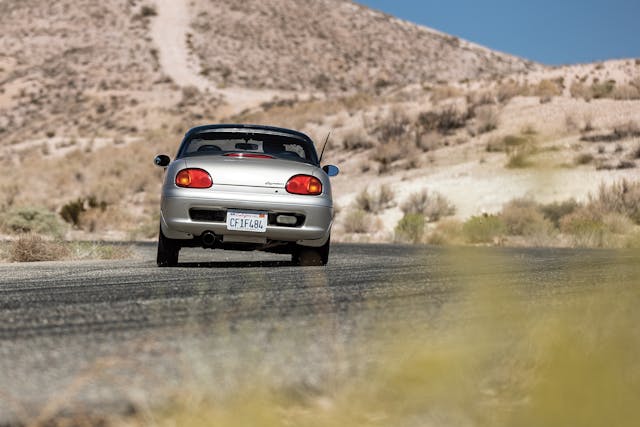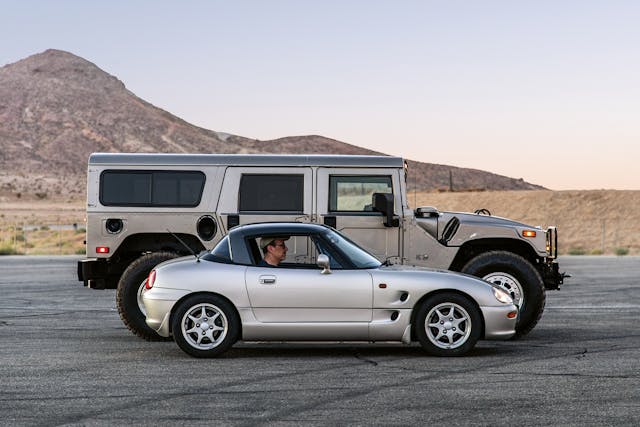Media | Articles
2023 Bull Market Pick: 1991–98 Suzuki Cappuccino
Welcome back to the Hagerty Bull Market List, our annual deep dive into the collector cars (and bikes) climbing the value ranks. This vehicle is one of 11 chosen for the 2023 installment of the List. To see the other 10, click here.
Here’s one to stump all those I-know-every-car car guys. The eensy Suzuki Cappuccino was a low-volume flash in the pan built exclusively for Japan’s domestic minicar segment. Ridiculously cute, it sold in the 1990s against the mid-engine Honda Beat and the gullwing-doored Autozam (Mazda) AZ-1, the latter also conceived by Suzuki with a Suzuki engine. All three cars are now highly collectible and, along with Nissan’s contemporary Figaro and S-Cargo, represent an all-too-brief moment of Japanese insanity.
In the late 1980s, with Japan’s bubble economy on boil, the country’s automakers were feeling frisky. Sporty concepts from Daihatsu to Subaru sprinkled the biennial Tokyo Motor Show, and Suzuki, best known locally for its small city cubes that sell in Japan’s low-tax keijidosha, or minicar, segment, decided to crash the party with a convertible funster that vaguely resembled the then-new Mazda Miata. However, the Cappuccino had certain notable differences.

First, its size, which—at 130 inches long and 55 inches wide—fell just within the keijidosha standards but was more than 2 feet shorter and nearly a foot narrower than the export-oriented Miata. Also, instead of canvas, the Suzuki’s roof is composed of three removable aluminum panels and a targa bar that can fold into the body. Thus, the Cappuccino can be a coupe, a T-top, a targa, or a full roadster. And the design was so crafty that the three roof panels neatly pack into a trunk that makes a clarinet case seem vast.

The engine in this first-gen Cappuccino (code name: EA11) is a dual-overhead-cam, 12-valve, turbocharged and port-injected three-banger based on the all-aluminum F6A that Suzuki was at the time shoving into its smallest cars as well as its Japanese domestic Jimny 4×4 (Samurai in the U.S.). Independent upper and lower control arms suspend the 14-inch wheels with their skinny 165/65-size radials. The curb weight was listed as 1543 pounds.
Marketplace
Buy and sell classics with confidence

The Cappuccino won’t light ’em up off the line with its advertised 63 horsepower. But once moving, it slaloms a twisty road like a Miata on Atkins, darting at corners with quick steering and a firm ride. The turbo packs usable torque into the lower ranges of the 8500-rpm tach, centrally located in the cluster as it should be. Boost is indicated by a green turbo light—so ’90s—and means that unlike the turbo-free Honda Beat, which also revs to 8500, you don’t have to scream the Cappo to redline in every gear just to keep up with traffic.
Suzuki may have done its job too well; aluminum was used liberally, and the deluxe interior trim, from its contoured buckets to its tilt/telescoping steering to its ruffled, leather-like door panels, probably meant the car was too expensive to turn a profit. Suzuki produced 26,480 Cappuccinos, fully 75 percent of them in the first 2 years, before faddish Japan lost interest and sales tanked in an economy mired by recession. Few have made it to North America, ensuring that this mini-Miata remains a rare sighting.
***
1991 Suzuki Cappuccino
Highs: Among alt Miatas, way more reliable than anything British; standard A/C; flexible roof arrangement; 42 mpg; deft handling; unlikely to see another one at the cars and coffee.
Lows: Anyone over 6 foot need not apply; body and trim bits getting scarce; many have been modified; not as rigid as a Miata, which is why shock braces and underbody shear plates were popular accessories.
Price range: #1 – $22,000 #2 – $14,000 #3 – $8500 #4 – $4000

HAGERTY AUTO INTELLIGENCE SAYS:
The Cappuccino never got the same attention as its fellow ABC kei cars, the Autozam AZ-1 and Honda Beat. However, demand for this more “practical” kei car is increasing. Imports have outpaced the Beat in recent years and average protected values are increasing at twice the rate of those for the Beat. Millennial and Gen Z enthusiasts submit over 80 percent of insurance quotes, which assures there will be a dedicated following in the future. It’s nearly impossible to find a more interesting car for under $10,000, assuming you can fit in one.

Check out the Hagerty Media homepage so you don’t miss a single story, or better yet, bookmark it.














how do i buy a suzuki 1990 cappccino
Easy, call Aaron, this one belongs to the author.
OMG i want one, they need to start making it again here in the US
Having seen the Cappucino here in Austin and when I lived in Houston the picture with the Hummer is funnier to me. Fun car, sounds good too with a nice intake and exhaust.
LOL…the ‘head shot’ in the car tells the story; makes the Miata look massive in comparison!